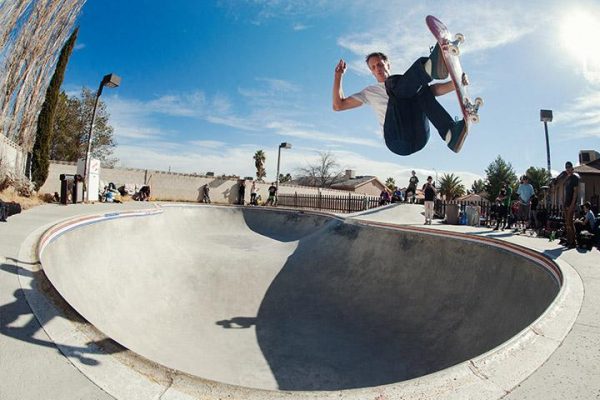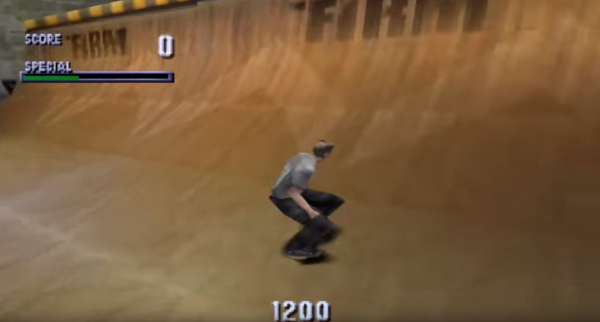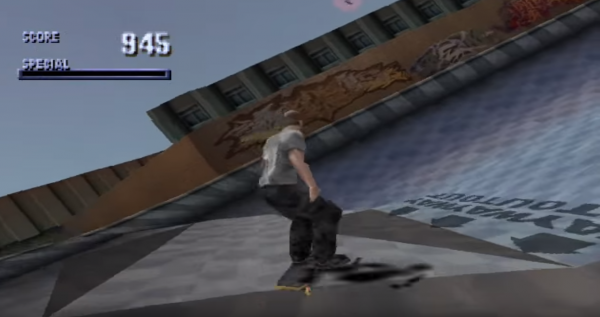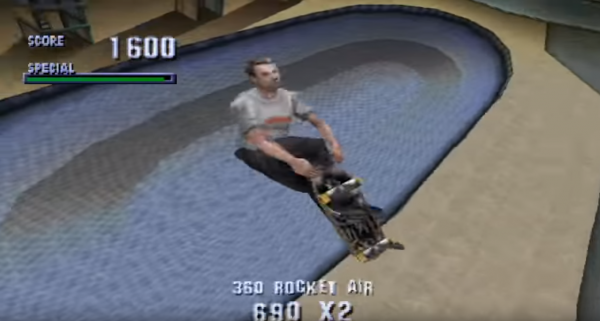Tony Hawk and Neversoft tell the story of making Tony Hawk’s Pro Skater first appeared on the site on April 26, 2018. In front of 275,000 people, June 27, 1999, at the San Francisco X Games, Tony Hawk tried eleven times to successfully land a 900 degree spin. On his twelfth attempt, he kept the skateboard under his feet and made history. A few months later, Activision released the video game, Tony Hawk’s Pro Skater, and the world grabbed hold of this previously fringe sport eagerly. Activision approached Tony Hawk the year before, in 1998. “We heard you’re working on a game, we’re working on a skate game and would like you to see what we’re doing,” Hawk remembers the publisher saying at the time. Hawk had already been attempting to bring a skate game into the world for years before that meeting. “A PC developer wanted to pitch a skate game to different publishers,” he explains. “We went to a couple of different meetings, he had a crude engine for a game - it wasn’t very involved or very exciting, but it was a start.”
Hawk and the PC developer parted ways after the developer became discouraged by executives who believed skating didn’t fit video games. Take Two reached out to Hawk and they bandied around some ideas, but it didn’t click. To Hawk, Activision must have seemed like a last ditch attempt. “I went to Santa Monica and they showed me their very early version of what would become Tony Hawk’s Pro Skater,” Hawk recalls. “I thought it had the most intuitive controls and a lot of free roaming capabilities.” The deal was signed and the tiny team at Neversoft took the reins in the hopes they could turn this niche sport into a blockbuster franchise. “The mission statement was basically ‘make a fun game about skateboarding’, but the first stage was ‘figure out what’s fun’,” Neversoft co-founder Mick West explains. West was working with Joel Jewett to oversee the project as it became the sole property the studio was developing. Activision needed this to be a success - the publisher had recently halted game development for the console market, wary of its future. West added to the mission statement: “Get as much fun stuff into the game as possible and ship before the holidays.” Producer of the first game, Ralph D’Amato, smiles as he reflects on the unofficial tagline for the company: “Work hard, party hard, Neversoft!”
This motto sums up the development process. Both D’Amato and West say development was like “shooting from the hip” and the production was “chaotic”, which are both phrases that could be used for describing the sport itself. Reflecting on the early days, D’Amato mentions a nearby arcade the team visited so they could play Top Skater. Doing so made them realise that they didn’t want to make a racing game - Tony Hawk’s Pro Skater needed to revolve around tricks in an “open-world style”. The team at Neversoft threw themselves into the sport both voluntarily and with encouragement from Joel Jewett, who had built a vert ramp in his own backyard. “About a year or so after it was built, Joel moved so a few of us went over to his house, disassembled the ramp, and moved it to my house instead,” D’Amato recalls. “We used the ramp for employee skate nights.” When this is brought up, Hawk laughs: “Joel Jewett is eccentric, to say the least, and he basically demanded that everyone on the team try to learn how to skate. He would take weekly trips to the skate parks and just go out and do it. He had a kickflip competition at one point… in the office.” Neversoft developed a passion and a real, practical knowledge of skateboarding, which allowed them to transfer the feel of doing it in real life into the game. “We really tried to immerse ourselves into skate culture,” says West, “We watched a lot of videos and got a lot of input from skaters”. Obviously, this was a Tony Hawk game, so the man himself was not left out. “Neversoft were calling me constantly”, Hawk admits. So much of the information came from the pro skater, and he would actively test out new builds of the game several times a week. “I was embedded with Neversoft from the get-go. I was driving up there all of the time, they were sending me discs a couple of times a week,” Hawk explains. “I had a modified PlayStation so I could use burned discs, and they’d send me new developments and we’d go back and forth.” Tony laughs to himself when asked if other skaters were playing the builds - “I’d let people play it, people that I trust. At one point, I felt it was getting so far along that I started to sneak out copies for those same people - these people had modded PlayStations. As subversive as that was, it started to create a buzz in the industry, because they were key players in the skating industry and they were also hardcore gamers.” D’Amato is visibly excited about working with Hawk and other skaters. “Part of my production duties were to schedule the skaters in for their character design and special tricks review,” he says. “It was fun because the skaters all had different personalities and were as excited as us.” His passion stayed with him, and he’s still a huge fan of skateboarding today.
It wasn’t all fun, though. “The most pressure would come from crazy deadlines,” D’Amato says. “It was like being on a sports team. Everyone was 100% dedicated to the project. Staff didn’t take vacations until the game was finished and our lives revolved around it.” While D’Amato is obviously proud of what his team created, it’s clear that it was a stressful environment. However, he describes his time working on the series with a huge fondness. “The biggest highlight was working with the small team of people on the first few titles,” D’Amato continues. “I’m still friends with a lot of them, they will be lifelong friendships, and that’s invaluable”. In all, it took around a year to put the initial game together. Research was the main focus, not just for tricks and skaters, but for the culture that surrounded the sport and the locations in which skating was born and thrived. The team would pick real world skate spots and if they were lacking on source material, they would head out across the United States to film more reference footage. Hawk himself, again, was the font of knowledge. “I pointed out a lot of locations, a lot of the genuine skate spots and parks,” he says. “Jamie Thomas was also involved and very vocal.” Because of Hawk’s input, skating came first and game mechanics came second. It was about transferring the sport, not reimagining it, and that is ultimately why it was so successful. “Neversoft was so open to my ideas, there was never a ‘we’re not going to do that because that’s not what video games are’,” Hawk says. “They liked that it was a canvas to explore what we wanted, and capture what we do, in the best way.” Of course, it was a video game, and it needed to be controlled like one for players to be able to access the vast number of tricks and potential combinations. “Once we nailed down the basics - ollie, grind, flip, and grab - everything else came naturally,” D’Amato explains. “The control scheme was changed up a fair bit at the beginning though.” At one point, the system meant hitting buttons in a combo while mimicking movement on the D-Pad, similar to a fighting game. In the end, the team decided on using a more simple method of holding directions and button combinations to perform tricks.
Hawk reminisces about the freedom he and Neversoft had: “There wasn’t something to live up to, it was liberating and we were free to try whatever.” Of course, they weren’t combatting anything except Top Skater and Thrasher’s Skate and Destroy, but there was pressure, not just on Neversoft, but also on Hawk, because this was his game, it would hold his name. When it finally released, the success came as a bit of a shock to the skater. “The idea that we created a genre of video games was unexpected,” Hawk says. “Action sports as a genre was something I never imagined.” Mick West knew the pressure well. “It meant everything to Neversoft for financial stability,” he recalls. The game became a huge success, selling over 350,000 units between the November 1999 release to Christmas that year, in America alone; lifetime sales were 300,000 for the UK. The game’s popularity also helped to establish a whole new fanbase for the sport and launch Tony Hawk to stardom - it was played by anyone and everyone. Somebody in a friendship group would own a copy of the game and everyone would bundle round to their house to ‘out trick’ each other. “The game raised my profile in terms of promotion and opportunities,” Hawk admits. “I was getting asked to do mainstream talk shows and cameos in movies. I never imagined being able to do these things.” The Pro Skater games were a landmark in popular culture and launched the careers of many, from Hawk himself to Johnny Knoxville and the Jackass crew, who embodied the culture of skating. Talk to anyone about the games and they all have favourite moments, skaters, or tricks. However, no matter who you talk to, they will mention the soundtrack, without which the game wouldn’t have held as much of the excitement and style that was so needed to create the sense of fun that West, D’Amato, and the team originally set out to capture. “The music, for me, it was important to represent the culture authentically and that meant the early days of skate punk; Dead Kennedy’s, Circle Jerks, Primus,” Hawk says. “But it was the music guys at Activision who brought in the newer punk bands.”
From speaking with the key players behind the games, everyone is incredibly fond of the legacy they created. There were things Neversoft and Hawk wanted to achieve in the beginning which couldn’t be captured until the switch to PlayStation 2 - for Tony, it was skating the loop; for others, it was stepping up the crazy tricks and locations. “Each dev cycle presented new hurdles,” D’Amato says as he remembers a moment of distress during development of the third game. “When 9/11 happened, we were almost finished with Pro Skater 3. We had an airport level where the goal was to stop terrorists bombing the plane. We had to scramble and change it to stopping pickpockets.” So many childhoods were shaped around video games and the Pro Skater series is fondly remembered by most players of a certain generation. The games set up many careers and left an impact on West, Hawk, and D’Amato - the latter went on to leave Neversoft and work directly with Hawk as his director of media. He is currently working on a documentary about the creation of the Pro Skater series. To see this content please enable targeting cookies. Manage cookie settings “I was proud, in general, of how it raised skating’s profile,” Hawk says. “A shocking moment, one that gave me most validation, was when we released the fourth game, the first three titles were still in the top ten for sales. That seemed unreal. Beyond any fantasy. Just the idea that we got to do one sequel, and we did four, and the first three were still top selling. I’m proud of what we created and the legacy of those games - I never imagined it would become what I’m known for, more than my actual skating,” he laughs. “It’s been crazy, it still resonates. Some of the things I get to do, in a lot of ways, are connected to that awareness that came from the video games.”



